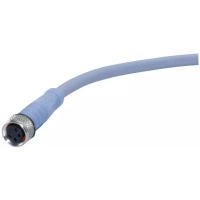IDEC SmartRelay installation and wiring
22
IDEC SmartRelay Manual
2.3 Wiring the IDEC SmartRelay
Wire the IDEC SmartRelay using a screwdriver with a 3-mm
blade.
You do not need wire ferrules for the terminals. Permitted
conductor cross-sections:
•1 x 2.5 mm
2
•2 x 1.5 mm
2
for each second terminal chamber
Tightening torque: 0.4...0.5 Nm or 3...4 lbs in
Note
Always cover the terminals after you have completed the installa-
tion. To protect IDEC SmartRelay adequately from impermissible
contact to live parts, local standards must be complied with.
2.3.1 Connecting the power supply
IDEC SmartRelays (FL1C-*12RCC, FL1B-M08C2R2) are
suitable for nominal line voltages of 100 V AC/DC and 240 V
AC/DC. IDEC SmartRelays (FL1C-*12RCA, FL1B-
M08D2R2) are suitable for a supply voltage of 24 V AC/DC.
IDEC SmartRelays (FL1C-H12SND, FL1B-M08B1S2) are
suitable for a supply voltage of 24 V DC. IDEC SmartRelays
(FL1C-*12RCE, FL1B-M08B2R2) are suitable for a supply
voltage of 12 V AC/DC or 24 V AC/DC.
Note the information on connection in the product informa-
tion document shipped with your device and the technical
specifications in Appendix A relating to permissible voltage
tolerances, line frequency and current consumption.
Note
A power failure may cause an additional edge triggering signal at
the special functions, for example.
Data of the last uninterrupted
cycle are stored in IDEC SmartRelay.
Courtesy of Steven Engineering, Inc. ● 230 Ryan Way, South San Francisco, CA 94080-6370 ● General Inquiries: (800) 670-4183 ● www.stevenengineering.com

